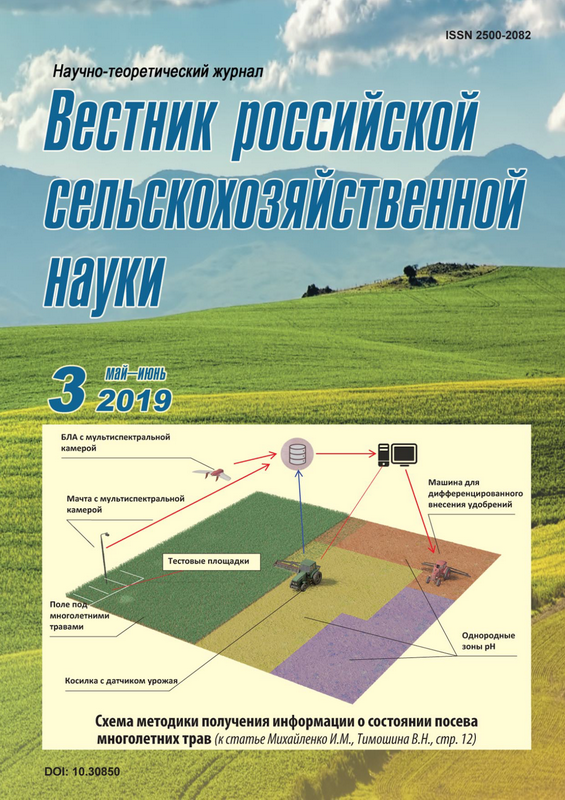Improvement of spring durum wheat selection methodologies under climate change conditions
- Authors: Grabovets A.I.1, Kadushkina V.P.1, Kovalenko S.A.1
-
Affiliations:
- Federal Rostov Agricultural Research Center
- Issue: No 3 (2019)
- Pages: 33-36
- Section: Agronomy
- URL: https://vietnamjournal.ru/2500-2082/article/view/15225
- DOI: https://doi.org/10.30850/vrsn/2019/3/33-36
- ID: 15225
Cite item
Abstract
With the growing aridity of the climate on the Don, it became necessary to improve the methodology for conducting the breeding of spring durum wheat. The main method of obtaining the source material remains intraspecific step hybridization. Crossings were performed between genetically distant forms, differing in origin and required traits and properties. The use of chemical mutagenesis was a productive way to change the heredity of genotypes in terms of drought tolerance. When breeding for productivity, both in dry years of research and in favorable years, the most objective markers were identified — the size of the aerial mass, the mass of grain per plant, spike, and harvest index. The magnitude of the correlation coefficients between the yield per unit area and the elements of its structure is established. It was most closely associated with them in dry years, while in wet years it decreased. Power the correlation of the characteristics of the pair — the grain yield per square meter — the aboveground biomass averaged r = 0.73, and in dry years it was higher (0.91) than in favorable ones (0.61—0.70), between the harvest and the harvest index — r = 0.81 (on average). In dry years, the correlation coefficient increased to 0.92. Research data confirms the greatest importance of the mass of grain from one ear and the plant in the formation of grain yield per unit area in both dry and wet years. In dry years, the correlation coefficient between yield and grain mass per plant was on average r = 0.80; in favorable years, r = 0.69. The relationship between yield and grain mass from the ear was greater — r = 0.84 and r = 0.82, respectively. Consequently, the breeding significance of the aboveground mass and the productivity of the ear, as a criterion for the selection of the crop, especially increases in the dry years. They were basic in the selection.
Keywords
Full Text
About the authors
A. I. Grabovets
Federal Rostov Agricultural Research Center
Author for correspondence.
Email: grabovets_ai@mail.ru
Corresponding member of RAS, Professor
Russian Federation, 346735, Rostovskaya obl., Aksajskij rajon, ul. Institutskaya, 1, pos. RassvetV. P. Kadushkina
Federal Rostov Agricultural Research Center
Email: grabovets_ai@mail.ru
Russian Federation, 346735, Rostovskaya obl., Aksajskij rajon, ul. Institutskaya, 1, pos. Rassvet
S. A. Kovalenko
Federal Rostov Agricultural Research Center
Email: grabovets_ai@mail.ru
master’s Degree student
Russian Federation, 346735, Rostovskaya obl., Aksajskij rajon, ul. Institutskaya, 1, pos. RassvetReferences
- Bespalova, L.A. Realizaciya modeli polukarlikovogo sorta akademika P.P. Luk'yanenko i eyo dal'nejshee razvitie. / L.A. Bespalova // Sb.: Pshenicza i tritikale. Mat. nauch.-prakt. konferencii «Zelenaya revolyuciya P.P. Luk'yanenko» — Krasnodar. — 2001. — S. 60-71.
- Grabovecz, A.I. Massa zerna — integral'ny'j pokazatel' adaptivnosti ozimoj pshenicy pri selekcii na zasuxoustojchi- vost' / A.I. Grabovecz, M.A. Fomenko // Izvestiya Oren- burgskogo GAU. — Orenburg. — 2014. — 5 (49). — S. 16—20.
- Grabovecz, A.I. Sovershenstvovanie metodologii selek- cii pshenicy v usloviyax nedostatochnogo uvlazhneniya / A.I. Grabovecz, M.A. Fomenko // Zernobobovy'e i krupyany'e kul'tury'. — Zernograd. — 2016. — 2 (18). — S. 48—53.
- Richards, Z.A. Priznaki, po kotory'm uluchshayut urozha- jnost' v usloviyax zasuxi. / Z.A. Richards, A.G. Kondon, G.Dzh. Rebeczke // Sb.: Primenenie fiziologii v selekcii pshenicy. — Kiev-Logos, — 2007. — S. 184—207
Supplementary files










